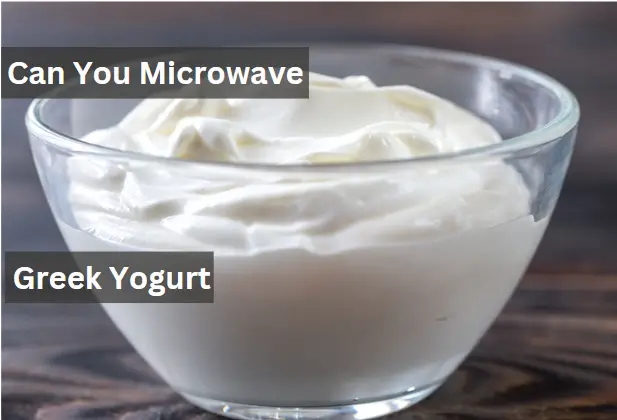Can You Microwave Greek Yogurt?
Hey guys, today I want to talk about a burning question that I’m sure many of you have asked yourselves, Can you microwave Greek yogurt?
Before we get into that, let’s quickly talk about what Greek yogurt is in case you’re not familiar with it. Greek yogurt is a creamy and thick yogurt that is strained to remove the excess liquid, giving it that signature texture we all love.
Now, why might you need to microwave it? Maybe you’re trying to make a warm yogurt sauce or add it to a hot dish, but I’m here to tell you that heating up Greek yogurt is a big no-no! When you heat up Greek yogurt, it can cause the protein and fat to coagulate, resulting in a clumpy and unappetizing mess.
But don’t fret, there are plenty of delicious ways to enjoy cold Greek yogurt, like adding it to smoothies or using it as a healthy substitute for sour cream.
Can You Microwave Greek Yogurt?
Greek yogurt is a popular and healthy snack that’s enjoyed by many for its creamy texture and high protein content. But can you microwave Greek yogurt? The answer is no. We do not recommend microwaving Greek yogurt, as it may cause the yogurt to separate or curdle, resulting in poor taste and texture. Additionally, if you heat greek yogurt, it may kill good bacteria that are essential to digestion and gut health.
Let’s look at some other reasons we do not recommend microwaving greek yogurt.
Is the Yogurt Container Microwave-Safe?
Even though we do not recommend microwaving Greek yogurt, it’s important to note that the container’s microwave safety is equally important. Always make sure that the container or dish you use to microwave Greek yogurt is microwave-safe.
Potential Bacterial Growth due to Heating
Heating up Greek yogurt can create a risk of unfriendly bacterial growth. Bacteria thrive in warm conditions, and your microwave provides the perfect environment for them to grow. This risk is a concern, especially if the yogurt has been sitting out at room temperature for long periods.
Tips for Preventing Overcooking or Burning
Low-powered microwaves, rotating the bowl or container, and heating it for short intervals while stirring in between is an effective way to prevent overcooking and burning the greek yogurt. It is important to keep an eye on the yogurt while it is in the microwave to make sure that it doesn’t overheat or become too hot.
Changes in Taste, Texture, and Nutritional Value
Microwaving Greek yogurt may cause some noticeable changes in taste, texture, and nutritional value. The low-fat content of the yogurt may affect its ability to withstand heat. Heating the yogurt may cause it to lose its thickness, and it may become runny or separate. Additionally, microwaving Greek yogurt may cause partial or entire loss of nutrients.
Guidelines or Recommendations for Safely Heating Greek Yogurt
If you still prefer to microwave Greek yogurt, follow these guidelines:
- Only use a microwave-safe container.
- Heat the yogurt on low power settings.
- Heat the yogurt for short intervals, no more than 10 seconds, and stir in between.
- Always keep an eye on the yogurt while it is in the microwave to be sure it isn’t overheating.
- Allow the yogurt to cool for a few minutes in the microwave before consuming.
In conclusion, we do not recommend microwaving Greek Yogurt. However, if you choose to do so, use a microwave-safe container and follow the above guidelines to avoid any potential problems that may occur.
What is Greek Yogurt?
Greek yogurt is made by straining regular yogurt to remove the whey, resulting in a thicker and creamier texture. It also has a higher protein content than regular yogurt due to the straining process.
In terms of nutritional values, one container of plain, nonfat Greek yogurt contains around 92 calories, while whole-milk Greek yogurt contains about 110-140 calories per container. Greek yogurt is a great source of calcium, potassium, and vitamin D, which are essential for strong bones and teeth . It also contains probiotics, which promote gut health and boost the immune system.
Greek yogurt has a tangy and slightly sour taste compared to regular yogurt, which can be attributed to its lower sugar content. It can be used to replace sour cream in recipes, used as a base for dips and dressings, or simply eaten on its own with added fruits and nuts.
What Happens When Greek Yogurt is Cooked?
Greek yogurt, like traditional yogurt, contains live bacteria cultures, specifically Lactobacillus bulgaricus and Streptococcus thermophilus, which ferment the milk to create a tangy and creamy texture. However, when heat is applied to Greek yogurt, its protein structure and acidity are altered.
The proteins in Greek yogurt become more concentrated when heated, as the whey is removed, resulting in a thicker and creamier texture. Additionally, the acidity of Greek yogurt increases when heated, which can affect its tartness and flavor.
When cooked, Greek yogurt can either thicken or become watery depending on the cooking method and duration.
If heated too quickly or for too long, the yogurt may curdle and separate, causing it to lose its desired texture. However, if you heat up Greek yogurt gently and slowly, it can be used as a substitute for cream in savory dishes, like stroganoff or chicken tikka masala, resulting in a healthier and protein-packed alternative.
Greek yogurt can also be used in sweet dishes like smoothies or as a topping for fruit, adding a tangy and nutritious boost to any meal.
Overall, the science behind Greek yogurt cooking involves altering the protein structure and acidity through heat, resulting in a thicker texture and altered flavor. With careful cooking techniques, Greek yogurt can be used in a variety of dishes to increase their nutritional value while also enhancing the flavor profile.
Will Greek Yogurt Curdle When Heated?
Greek yogurt is more likely to curdle than regular yogurt when heated due to its high protein content. When heated, the protein strands in the yogurt tighten up and congeal, causing the curdling effect. However, there are ways to prevent this from happening.
One smart trick to avoid Greek yogurt from curdling is to add a small portion of gravy to the yogurt and whisk it in. This act is called “tempering,” and it helps to gradually raise the temperature of the yogurt without causing the protein strands to tighten too quickly. Another way to prevent curdling is to add a teaspoon or two of flour to the yogurt before adding it to the heated ingredient.
It is important to note that while Greek yogurt is more likely to curdle than regular yogurt, all types of yogurt will curdle when heated.
Factors that can cause yogurt to curdle include:
- prolonged storage in the refrigerator
- excessive heat during cooking.








